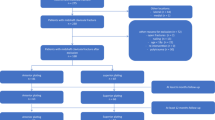Abstract
Purpose
The purpose of this study was to determine whether anterior plating is better tolerated than superior plating for midshaft clavicle fractures.
Methods
This was a prospective non-randomized observational cohort study following operative vs. non-operative management of clavicle fractures from 2003 to 2018 at 7 level 1 academic trauma centers in the USA. The subset of patients treated with plate and screws is the basis for this comparative study. Adults aged 18–85 with closed clavicle fractures displaced over 100% or shortened by more than 1.5 cm were eligible for enrollment. Patients were followed for 2 years following enrollment. Allowable fixation methods at the discretion of the surgeon consisted of anterior–inferior or superior plating. A total of 412 patients were enrolled. Of these, 192 patients received either superior or anterior plating for a displaced clavicle fracture with complete documented prospective research forms capturing type of plating technique. The primary outcome measure was hardware removal (HWR). Secondary outcomes were Disability of the Arm Shoulder and Hand (DASH) score and Visual Analog Pain (VAP) score, and satisfaction score (1 = high satisfaction; 5 = low satisfaction).
Results
There was no difference in HWR rates (7.1% superior 9/127; 6.2% anterior 4/65, p = 0.81), VAP score (mean 1.5 SD 1.0 superior; mean 1.7 SD 0.6 anterior, p = 0.21), DASH score (mean 7.5 SD 12.4 superior; mean 5.2 SD 15.2 anterior; p = 0.18) or satisfaction score (mean 1.6 SD 1.0 superior; mean 1.7 SD 0.60 anterior, p = 0.18).
Conclusion
There is no difference in HWR rates or functional outcomes when using a superior vs. anterior plating technique.

Similar content being viewed by others
References
Postacchini F, Gumina S, De Santis P, Albo F (2002) Epidemiology of clavicle fractures. J Shoulder Elbow Surg 11:452–456
Nordqvist, A. & Petersson, C. (1994): The incidence of fractures of the clavicle. Clin Orthop Relat Res, 127–132
Trauma CO, S. (2007) Nonoperative treatment compared with plate fixation of displaced midshaft clavicular fractures. A multicenter, randomized clinical trial. J Bone Joint Surg Am 89:1–10
Zlowodzki M et al (2005) Treatment of acute midshaft clavicle fractures: systematic review of 2144 fractures: on behalf of the evidence-based orthopaedic Trauma Working Group. J Orthop Trauma 19:504–507
Kloen P, Sorkin AT, Rubel IF, Helfet DL (2002) Anteroinferior plating of midshaft clavicular nonunions. J Orthop Trauma 16:425–430
Collinge C, Devinney S, Herscovici D, DiPasquale T, Sanders R (2006) Anterior-inferior plate fixation of middle-third fractures and nonunions of the clavicle. J Orthop Trauma 20:680–686
Serrano R et al (2017) Anterior-inferior plating results in fewer secondary interventions compared to superior plating for acute displaced Midshaft clavicle fractures. J Orthop Trauma 31:468–471
Franchignoni F et al (2014) Minimal clinically important difference of the disabilities of the arm, shoulder and hand outcome measure (DASH) and its shortened version (QuickDASH). J Orthop Sports Phys Ther 44:30–39
Tashjian RZ, Deloach J, Porucznik CA, Powell AP (2009) Minimal clinically important differences (MCID) and patient acceptable symptomatic state (PASS) for visual analog scales (VAS) measuring pain in patients treated for rotator cuff disease. J Shoulder Elbow Surg 18:927–932
Fitzgerald EM, Moore DM, Quinlan JF (2022) A review of outcomes after operative fixation of clavicular fractures over a 10-year period-a single tertiary trauma unit experience. JSES Int 6:264–267
Naimark M et al (2016) Plate fixation of midshaft clavicular fractures: patient-reported outcomes and hardware-related complications. J Shoulder Elbow Surg 25:739–746
Nourian A, Dhaliwal S, Vangala S, Vezeridis PS (2017) Midshaft fractures of the clavicle: a meta-analysis comparing surgical fixation using anteroinferior plating versus superior plating. J Orthop Trauma 31:461–467
Sheth U, Fernandez CE, Morgan AM, Henry P, Nam D (2022) Are two plates better than one? A systematic review of dual plating for acute midshaft clavicle fractures. Shoulder Elbow 14:500–509
Zielinski E, Doe K, Perdue P (2022) Dual plate minifragment fixation of clavicle fractures- technique and approach. J Orthop Trauma 36:S1–S2
Acknowledgements
This study was performed through the Southeastern Fracture Consortium with the writing committee consisting of the authors. Each site PI for the Southeastern Fracture Consortium is considered a co-author of this manuscript by the Vancouver model. The authors declare no conflict of interest for this study.
Funding
This study was funded by a grant from the Orthopaedic Trauma Association.
Author information
Authors and Affiliations
Consortia
Contributions
All authors contributed to patient enrollment and participated in manuscript preparation.
Corresponding author
Ethics declarations
Conflict of interest
The authors have no relevant financial or non-financial interests to disclose.
Informed consent
This study was IRB approved and all patients provided written informed consent prior to enrollment.
Ethical approval
This study was approved by each institutional IRB, and informed consent was obtained from all patients prior to enrollment. This study complies with current US laws.
Additional information
Publisher's Note
Springer Nature remains neutral with regard to jurisdictional claims in published maps and institutional affiliations.
Rights and permissions
Springer Nature or its licensor (e.g. a society or other partner) holds exclusive rights to this article under a publishing agreement with the author(s) or other rightsholder(s); author self-archiving of the accepted manuscript version of this article is solely governed by the terms of such publishing agreement and applicable law.
About this article
Cite this article
Mullis, B.H., Jeray, K.J., Broderick, S. et al. Midshaft clavicle fractures: is anterior plating an acceptable alternative to superior plating?. Eur J Orthop Surg Traumatol 33, 3373–3377 (2023). https://doi.org/10.1007/s00590-023-03563-5
Received:
Accepted:
Published:
Issue Date:
DOI: https://doi.org/10.1007/s00590-023-03563-5




